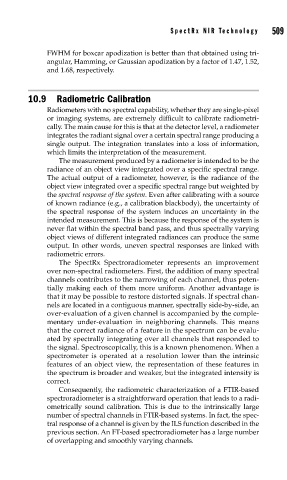Page 556 - Sensors and Control Systems in Manufacturing
P. 556
SpectRx NIR Technology
FWHM for boxcar apodization is better than that obtained using tri- 509
angular, Hamming, or Gaussian apodization by a factor of 1.47, 1.52,
and 1.68, respectively.
10.9 Radiometric Calibration
Radiometers with no spectral capability, whether they are single-pixel
or imaging systems, are extremely difficult to calibrate radiometri-
cally. The main cause for this is that at the detector level, a radiometer
integrates the radiant signal over a certain spectral range producing a
single output. The integration translates into a loss of information,
which limits the interpretation of the measurement.
The measurement produced by a radiometer is intended to be the
radiance of an object view integrated over a specific spectral range.
The actual output of a radiometer, however, is the radiance of the
object view integrated over a specific spectral range but weighted by
the spectral response of the system. Even after calibrating with a source
of known radiance (e.g., a calibration blackbody), the uncertainty of
the spectral response of the system induces an uncertainty in the
intended measurement. This is because the response of the system is
never flat within the spectral band pass, and thus spectrally varying
object views of different integrated radiances can produce the same
output. In other words, uneven spectral responses are linked with
radiometric errors.
The SpectRx Spectroradiometer represents an improvement
over non-spectral radiometers. First, the addition of many spectral
channels contributes to the narrowing of each channel, thus poten-
tially making each of them more uniform. Another advantage is
that it may be possible to restore distorted signals. If spectral chan-
nels are located in a contiguous manner, spectrally side-by-side, an
over-evaluation of a given channel is accompanied by the comple-
mentary under-evaluation in neighboring channels. This means
that the correct radiance of a feature in the spectrum can be evalu-
ated by spectrally integrating over all channels that responded to
the signal. Spectroscopically, this is a known phenomenon. When a
spectrometer is operated at a resolution lower than the intrinsic
features of an object view, the representation of these features in
the spectrum is broader and weaker, but the integrated intensity is
correct.
Consequently, the radiometric characterization of a FTIR-based
spectroradiometer is a straightforward operation that leads to a radi-
ometrically sound calibration. This is due to the intrinsically large
number of spectral channels in FTIR-based systems. In fact, the spec-
tral response of a channel is given by the ILS function described in the
previous section. An FT-based spectroradiometer has a large number
of overlapping and smoothly varying channels.

